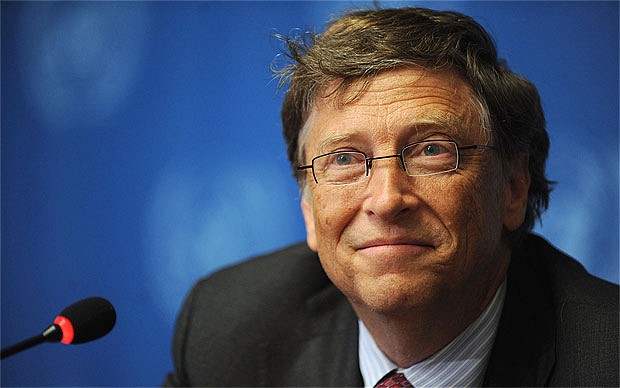Iam sharing a summarized version of the Bill and Melinda Gates 2015 Annual letter to my friends, development colleagues and fans of this column in an attempt to inspire them to be ambitious and goal getters towards ensuring the survival of women and children. They started sharing annual letters in 2009 not to their employees or those managing their investment but to everyone with the mind set of taking a risk to invest positively for a genuine cause that will change the way we operate capable of leading to impactful progress in our lives.
The 2015 annual letter started with a ‘Our Big Bet’ – the lives of people in poor countries will improve faster in the next 15 years than at any other time in history and their lives will improve more than anyone else’s.
The 2015 annual letter is focusing on 4 elements as they put it ‘We’re excited to see how much better the world will be in 15 years. Here are some of the breakthroughs we see coming.’
- Deaths will go down and more dieseases will be wiped out
- Africa will be able to feed itself
- Mobile Banking will help the poor transform their lives
- Better software will help revolutionize learning
My summary will dwell on the health component of the letter as ‘health’ is the mandate of this column.
UNTIL RECENTLY, THE WORLD WAS SPLIT IN TWO:
The letter observed that in one half, virtually all children were vaccinated, had sufficient nutrition, and received proper treatment for common illnesses like diarrhea and pneumonia. The number of children in this half who died before they reached the age of 5 was well under 1 percent. Then there was the other half. Here, vaccination coverage was spotty at best, children tended to be malnourished, and standard childhood illnesses went untreated. About 10 percent of these children died before they turned 5; in some countries that percentage was much higher.
Below are some achievements that are within the grasp of the “other” half of the world:
- Cutting the number of children who die before age 5 in half again.In 1990, one in ten children in the world died before age 5. Today, it’s one in 20. By 2030, that number will be one in 40. Almost all countries will include vaccines for diarrhea and pneumonia, two of the biggest killers of children, in their immunization programs. Better sanitation — through simple actions like hand-washing as well as innovations like new toilets designed especially for poor places — will cut the spread of disease dramatically. And we’re learning how to help more mothers adopt practices like proper breastfeeding and skin-to-skin contact with their babies that prevent newborns from dying in the first month after they’re born. (Newborn deaths have gone down at a slower rate than deaths of older children and now account for almost half of all child deaths.)
- Reducing the number of women who die in childbirth by two thirds.In countries around the world, more and more mothers are giving birth in health care facilities instead of at home. Since 2005, for example, the proportion of mothers delivering at facilities in Rwanda has gone from 31 percent to 72 percent. In Cambodia, it has shot up from 20 percent to 57 percent. By continuing to make sure that the caregivers at those facilities are well-supplied and well-trained, we can take advantage of this global trend and make childbirth much safer for women around the world. In addition, maternal mortality will drop as more women get access to contraceptives and information about spacing their pregnancies safely.
- Wiping Polio and three other diseases off the face of the earth.Destroying a disease utterly is a very difficult thing to do — so difficult, in fact, that it’s happened only once in history, when smallpox was eradicated in 1980. But if we keep working hard, we can eradicate four diseases by 2030. We can get polio out of Africa this year and out of every country in the world in the next several years. Guinea worm, an incredibly painful disease whose sufferers spend months incapacitated while worms that can be several feet long burst out of their legs, will also be gone soon, thanks in large part to the leadership of President Jimmy Carter and the Carter Center. We’ll also see the last of diseases like elephantiasis, river blindness, and blinding trachoma, which disable tens of millions of people in poor countries.
- Finding the secret to the destruction of Malaria.We won’t be able to completely eradicate malaria by 2030, but we will have all the tools we need to do so. These will include a vaccine that prevents people with malaria from spreading it to the mosquitoes that bite them, a single-dose cure that clears the parasite completely out of peoples’ bodies, and a diagnostic test that can reveal right away whether a person is infected.
- Forcing HIV to a tipping point.As we make progress toward a vaccine or a cure, the number of people beginning treatment in sub-Saharan Africa will finally outstrip the number of people newly infected. When we reach that point in the region with the most dense HIV transmission in the world, cases will start going down everywhere around the globe for the first time since the disease was discovered more than 30 years ago.
All well-meaning citizens of the world should rally round this letter as it provides a succinct explanation of what we can do to ensure a productive life for all.
1st published in Daily Trust Newspaper of 17th Feb 2015 by Dr Aminu Magashi Publisher Health Reporters (healthweekly@yahoo.com)




